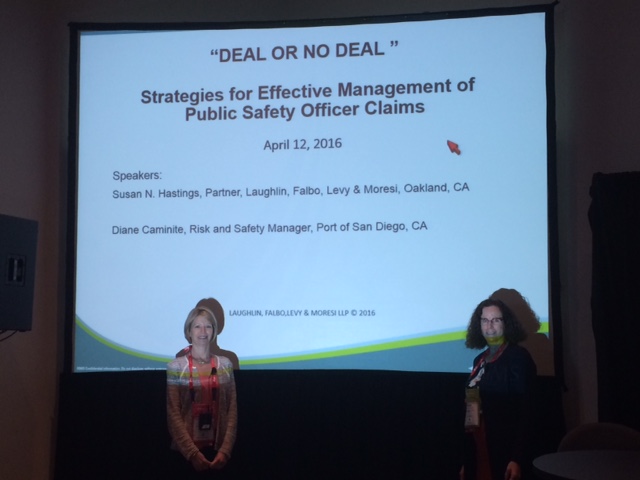Deal or No Deal: Strategies for Effective Management of Public Safety Officer Claims
Safety officer claims for work-related injuries are unique and expensive, thus it is important to effectively manage these claims.
The RIMS 2016 speakers for this session were:
- Diane Caminite, Risk & Safety Manager, San Diego Unified Port District
- Susan Hastings, Partner, Laughlin, Falbo, Levy & Moresi
This session’s speakers are from California and talked about labor code 4850 under Workers’ Compensation. Here, when a safety officer is injured and unable to work, labor code 4850 comes into play. After qualification, the 4850 salary continuation benefit will provide full salary for up to a year among other benefits.
Special presumptive injuries have been legislatively enacted for certain safety members. The presumption is an assumption of fact that the law requires to be made from another fact formed in the case. They are either conclusive where you cannot dispute them or rebuttable where you can present evidence to overcome what is presumed to be true.
Safety officers are given special benefits because these employees provide a vital and hazardous service. They are rebuttable presumptions; however, thus the burden of proof shifts to the employer.
The presumption for certain illnesses is such that the specific illness outlines in the statutes arose out of the course of employment if “it developed and manifested itself during the employment period, or for a specifically defines period post-service.” These illnesses might include heart trouble in the form of a pathology or abnormality, pneumonia with a medical diagnosis, tuberculosis (applying to firefighters and those engaged in first aid response), low back issues requiring a “duty belt” as a condition of employment, and cancer when it develops or manifests during the course of employment. (Prostate cancer and skin cancer have been among the most prevalent in California.)
Under the post-service extension of the presumption, the time to file a claim for injuries can be extended past the last actual service date. This will vary with years of service.
The speakers briefly talked about the importance of disability retirements and that accomplishing an IDR is not as easy as filling out a form. There are considerations in the process including the application process, determining the legal standards for disability retirement and other considerations.
One of the positive points of disability retirements are that they are an important part of managing public safety workers to financially protect those who have lost their health and/or work ability in performing public service. A negative is the high cost, an example being a young safety officer whose retirement will equal 50% of final compensation for life, and that can in turn top $1 million!


